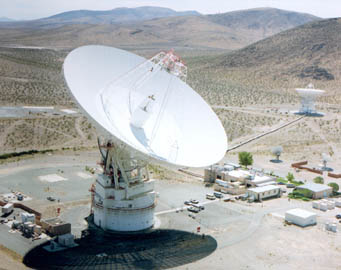Few things are more dramatic in interplanetary exploration than receiving that first crucial "I've arrived" message from a far-flung craft or regaining radio contact with one after some risky maneuver. For more than 40 years, mission teams in the U.S. and elsewhere have gotten word on the status of their robotic emissaries using NASA's worldwide set of tracking dishes — collectively called the Deep Space Network.

The 230-foot (70-m) antenna at Goldstone, California, against the background of the Mojave Desert. The dish on the right is a 34-m newer and more capable high-efficiency antenna.
NASA / JPL
Managed by the Jet Propulsion Laboratory, the DSN consists of three antenna clusters, two in the Northern Hemisphere and one in Australia, spaced more or less equally in longitude. For convenience, they're said to be located at "Goldstone" (nothing more than an abandoned mine and ghost town) in California's Mojave Desert, "Canberra" (actually situated in Australia's Tidbinbilla Valley), and "Madrid" (technically 20 miles west of the city in Robledo de Chavela, Spain).
Whatever you call them, the DSN's dozen dishes are constantly in demand, maintaining contact with nearly 50 spacecraft. But not every mission gets all the tracking time it wants — in 2008 about 25% of tracking requests never happened — and even bigger scheduling problems loom on the horizon.
An especially bad "asset contention period," as the dish jockeys call it, comes in 2015. That's when New Horizons zips past Pluto, Dawn settles into orbit around Ceres, and the European probe Rosetta reaches Comet 67P/Churyumov-Gerasimenko — and that's not counting four other deep-space missions that will need support during their launch and all the other craft needing some quality time with their scientists and engineers.
So the DSN's caretakers have just kicked off a major program to fortify their complexes with new antennas and to provide arguably its most important receiver with some much-needed TLC.
Topping the list are adding two 110-foot (34-m) high-efficiency antennas at the Australian site, which has only three dishes right now. (The U.S. and Australia have cooperated in spacecraft tracking since 1960, a partnership dramatized in the 2000 movie The Dish.) New 34-m receivers will be added in California and Spain as well.
Each station will also have one of its existing antennas upgraded to transmit in the high-frequency Ka band (which permits high data rates through a relatively small antenna).
Finally, DSN managers will take pains to extend the life of the towering 230-foot (70-m) behemoths that dominate each DSN site. NASA hopes to get another 10 to 20 years of life out of the Big Three, which have been workhorses for four decades (Goldstone's was build in 1966).
Already under way is what's being called "major surgery" involving the gigantic bearings on which Goldstone's big dish turns in azimuth and altitude. Talk about your engineering challenges! For this joint replacement, engineers must first raise the entire 9,000,000-pound structure by just under ¼ inch (5 mm). The repairs should be complete by November.
But the 70-m dishes won't last forever — moreover, they can't be upgraded to handle the Ka band. So they'll eventually be decommissioned, though not until all the new ones are operational. That's reassuring to asteroid scientist Lance Benner, who uses the big Goldstone dish (a.k.a. DSS 14) to bounce radar pulses off small asteroids passing near Earth.
"We have a new radar capability that uses 'chirped' waveforms," he explains. When asteroid 2010 AL30 approached within
one third of the Moon's distance in January, the new system yielded range measurements accurate to about 12 feet (3.75 m) — "a five-fold improvement," Benner beams, "and twice as fine as the highest range resolution available at Arecibo."
I've been lucky enough to visit all three DSN sites — and I've crawled around on the 70-m giants in California and Australia. To look out across these antennas' curved surfaces is a surreal experience — one I hope to repeat in Spain someday to complete my tracking-station trifecta.
 3
3
Comments
Pete Jackson
March 19, 2010 at 11:07 am
Hopefully,in an emergency, they should be able to use the 100m GBT at the National Radio Astronomy Observatory in Green Bank, West Virginia.
You must be logged in to post a comment.
Robert Brand
March 21, 2010 at 3:13 am
We are close to being able to build a global Deep Space Network with some real capability. There will be a serious opportunity to create the network and assist with the bottleneck of the comms with spacecraft headed out to the moon and beyond - Even the Google Lunar X-Prize participants will need good comms.
http://echoesofapollo.com/2010/03/09/building-a-new-deep-space-network-q-and-a/
Robert Brand
Echoes of Apollo
You must be logged in to post a comment.
Robert Brand
March 21, 2010 at 3:18 am
Just to be clear, This is not an Echoes Of Apollo activity. They have been kind enough to let me use the website to reach their subscriber list. The GDSN group is ready to acquire dishes in Europe, USA and Australia and is readying its business case. We are looking for potential customers and stakeholders, so if you need launch support in 2011 and beyond, please contact us.
Regards, Robert Brand
You must be logged in to post a comment.
You must be logged in to post a comment.